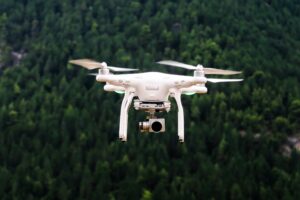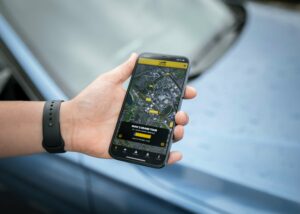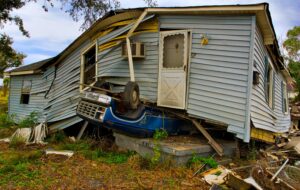In today’s world, natural disasters have become inevitable. There are hundreds of them worldwide, which means that governments and societies need to remain on alert and prepared for a black sky disaster, especially the ones that can take place without warning. Fortunately, modern black sky technology is helping with the response and recovery process of all types of disasters, making it easier for people and communities to get back to normal after a disaster. Let’s take a closer look at the types of black sky technologies that are making it easy to respond to disasters and recover from them.
Drones

In the immediate aftermath of disasters, drones, and other unmanned vehicles are becoming key in recovery and humanitarian efforts. This is because these vehicles can travel to places that might be inaccessible to humans in the wake of a disaster. If nothing else, drones with cameras can be flown over an area to help provide an immediate assessment of the damage.
While planes and helicopters have been used in the past for this type of work, drones are lighter and cheaper to operate. They can also fly closer to the ground, providing a more detailed assessment of the damage done, enabling those on the ground to see what areas are most in need of help and what areas might be unstable or unsafe in the wake of a disaster. Perhaps more importantly, infrared cameras can be attached to drones to help detect the location of people who need to be rescued. These types of machines can be invaluable in responding to a disaster by providing eyes on the ground for officials and providing real-time visual updates on the situation.
GIS Mapping
GIS technology has been around for decades and has a variety of uses, including disaster response. With GIS, officials can look at an area in a variety of ways. For instance, experts can look at GIS topographic maps that show elevation changes, which is particularly important in the aftermath of a flood to determine in which direction the water will flow. Needless to say, this is information that emergency response teams will want to know so that they can avoid the most dangerous areas. Of course, in any disaster response, the map of an area will be essential to creating rescue, response, and recovery plans. With GIS technology, any kind of map that could prove useful in that situation can be created to help officials make the best choices and develop effective plans.
Situational Awareness Operating Systems

As mentioned, the best tool in any disaster situation can simply be having accurate and up-to-date information. With black sky technology, like a situational awareness operating system, those making decisions at critical times will have the best information available. We can integrate such as system across multiple infrastructures without sharing proprietary data. In other words, there is a data feed that can help decision-makers stay up to date on everything happening and make appropriate decisions based on that data to aid in emergency response.
The Cloud
Cloud-based applications have transformed modern technology and our societies in a variety of ways. But this is also a useful tool to have for disaster relief and management. If there is local infrastructure damaged because of a natural disaster, communication systems and access to data could be cut off. However, if data is stored in the cloud, it can still be accessed even if other points of access have been cut off. With the cloud, local agencies that need to get to work in the aftermath of a disaster can still go about their business with minimal disruption. Needless to say, this helps immensely with response times in situations when time is of the essence.
Black Sky Communication System
 In the aftermath of a large-scale catastrophe or natural disaster, communication will be of the utmost importance. Government officials and leaders will need to communicate with those on the ground, while frightened people will be trying to get in touch with friends and family. Unfortunately, communications systems can easily be down during this time, creating the need for a Black Sky-class communication system. Without cellphone capabilities, there is a need for emergency communication systems that can keep communication devices connected during an emergency and keep everyone in touch, especially those who are leading the disaster recovery effort.
In the aftermath of a large-scale catastrophe or natural disaster, communication will be of the utmost importance. Government officials and leaders will need to communicate with those on the ground, while frightened people will be trying to get in touch with friends and family. Unfortunately, communications systems can easily be down during this time, creating the need for a Black Sky-class communication system. Without cellphone capabilities, there is a need for emergency communication systems that can keep communication devices connected during an emergency and keep everyone in touch, especially those who are leading the disaster recovery effort.
Data Collection
Following a disaster, massive amounts of data and information will be collected rapidly. The identities of survivors need to be tracked. People receiving medical care need that information logged. The efforts of first responders and rescue workers should be documented. There also needs to be data collected about road conditions and access points for emergency responders.
Fortunately, modern black sky technology is making it a little easier to collect and manage the massive data that accumulates during a disaster. For example, the American Red Cross has a way to map out road closures, emergency shelters, and even flood levels, making it easier to assess the situation and direct people to safety. Of course, the key to doing this is collecting information in real-time, which is possible thanks to modern technologies.
Supply Chain Security
 Businesses of all sizes can be hit hard in the wake of a disaster, and in some cases, those businesses need to get back to operating normally as quickly as possible to help aid in the recovery process. For instance, fuel stations and grocery stores need to be open and accessible for people who are dealing with disaster recovery. If there is a prolonged disruption to the supply chain, it can slow disaster response and recovery. This creates the need for black sky technology, such as supply chain security systems, that can help guard against vulnerabilities.
Businesses of all sizes can be hit hard in the wake of a disaster, and in some cases, those businesses need to get back to operating normally as quickly as possible to help aid in the recovery process. For instance, fuel stations and grocery stores need to be open and accessible for people who are dealing with disaster recovery. If there is a prolonged disruption to the supply chain, it can slow disaster response and recovery. This creates the need for black sky technology, such as supply chain security systems, that can help guard against vulnerabilities.
Facial Recognition Software
Most people associate facial recognition software with security and law enforcement practices. But it can also be useful following a disaster. Several countries have used this technology to help disaster victims who lost their belongings and critical documents to prove their identity and get new identification documents. Obviously, this doesn’t help victims in the immediate aftermath of a disaster. But as people try to rebuild their lives after losing everything in a disaster, facial recognition software can help expedite the process of replacing some of their important documents
Disaster Prediction

Of course, one of the best ways to aid in disaster response and recovery is to predict when a disaster might strike and prepare for it. Granted, we can’t predict every disaster. But there are black sky technologies that are helping to do just that for certain types of disasters and emergencies. More than ever, researchers can collect and analyze data more efficiently to predict which areas may be affected by hurricanes, tornadoes, floods, and other natural disasters. This can give emergency response teams a heads-up on where they will be needed the most. Likewise, past disaster data can be collected, allowing emergency responders to better understand the mistakes of previous disaster responses and improve their response in future disasters.
Final Note
In summary, technology has proven to be a critical factor in enhancing disaster response and recovery efforts. With continued investment in technology, we can expect to see even more significant advancements in disaster management in the future, thanks to emerging technologies like AI, blockchain, and wearable tech. These advancements will undoubtedly save more lives and help communities recover faster and more efficiently after disasters.
If you want to learn more about the black sky technologies we are developing, be sure to visit our technology page. Please reach out to us at any time if you have any questions or concerns. Together we can build a better future.
Create Impact with us:
Join our membership and
contribution programs
Participate in our
upcoming events:
Schedule a call with
our experts:
Cyber Resilience in the Energy Sector: Safeguarding the Grid from Digital Disruptions
In today’s interconnected world, the energy sector stands as a vital backbone of national and global infrastructures, facilitating everything from lighting our homes to powering industries. However, this sector is increasingly finding itself in the crosshairs of cybercriminals, making cyber resilience not just a matter of technological integrity but of national security. The concept of […]
The Role of Local Governments in Strengthening Infrastructure Resilience
The significance of local governments in strengthening infrastructure resilience cannot be understated. Often perceived as entities primarily focused on addressing routine community concerns and improvements, their responsibilities extend far beyond these day-to-day operations. In the realm of preparing for and mitigating the effects of large-scale, catastrophic events—referred to as “black sky” disasters—local governments emerge as […]
Navigating Complex Interdependencies and Building Resilience in the E-Sector
In today’s interconnected world, the electric sector is more than just a utility provider; it’s a cornerstone of modern life. Its influence extends beyond mere power supply, touching virtually every aspect of our daily activities, from powering homes and businesses to fueling transportation and technology. This pivotal role, however, is not without its complexities. The […]
